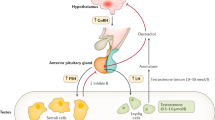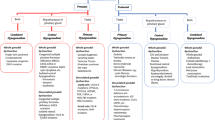Abstract
THE occurrence of familial and nonfamilial cases of hypogonadotrophic hypogonadism and hyposmia or anosmia (Kallman's syndrome) has been well documented1,2. Because the disease has been found only in humans, little is known about the site of the gonadotrophic lesion. Pathological examination of the pituitary glands of these patients has not revealed any abnormality3. No estimates of pituitary gonadotrophin content in patients with hypogonadotrophic hypogonadism are available, although patients who have normal amounts of circulating follicle stimulating hormone but who lack luteinizing hormone (LH)—the so-called “fertile eunuch syndrome”—have been described. In contradistinction to the Kallman syndrome, these (potentially) fertile patients have a normal sense of smell and testicular development with varying degrees of spermatogenesis4. Injections of gonadotrophic substances cause an appropriate gonadal response in patients with Kallman's syndrome5 and the lesion is considered to be central in origin6. Attempts to stimulate the release of gonadotrophin in these patients by the use of the antioestrogen clomiphene citrate have been unsuccessful7.
This is a preview of subscription content, access via your institution
Access options
Subscribe to this journal
Receive 51 print issues and online access
$199.00 per year
only $3.90 per issue
Buy this article
- Purchase on Springer Link
- Instant access to full article PDF
Prices may be subject to local taxes which are calculated during checkout
Similar content being viewed by others
References
Kallman, F., Schonfeld, W. A., and Barrera, S. E., Amer. J. Ment. Defic., 48, 203 (1944).
Nowakowski, H., and Lenz, W., Recent Prog. Hormone Res., 17, 53 (1961).
Gautier, G., Acta Neuroveg., 21, 345 (1960).
Faiman, C., Hoffman, D. L., Ryan, R. J., and Albert, A., Mayo Clin. Proc., 46, 661 (1968).
Paulsen, C. A., in Textbook of Endocrinology, fourth ed. (edit. by Williams, R. H.), 405 (Saunders, Philadelphia, 1968).
Bardin, C. W., Ross, G. T., Rifkind, A. B., Cargille, C. M., and Lipsett, M. B., J. Clin. Invest., 48, 2046 (1969).
Bardin, C. W., Ross, G. T., and Lipsett, M. B., J. Clin. Endocrinol., 27, 1558 (1967).
Gregory, H., Walpole, A. L., Charlton, H. M., Harris, G. W., and Reed, M., in Pharmacology of Hormonal Polypeptides and Proteins (edit. by Martini, L., and Paoletti, R.), 123 (Plenum Press, New York, 1968).
Naftolin, F., Espeland, D., Tremann, J. A., Dillard, E. A., and Paulsen, C. A., in Gonadotropins (edit. by Rosemberg, E.), 373 (Geron-X, Los Altos, California, 1968).
Bayman, I. W., Harris, G. W., and Naftolin, F., J. Physiol., 210, 3P (1970).
Author information
Authors and Affiliations
Rights and permissions
About this article
Cite this article
NAFTOLIN, F., HARRIS, G. & BOBROW, M. Effect of Purified Luteinizing Hormone Releasing Factor on Normal and Hypogonadotrophic Anosmic Men. Nature 232, 496–497 (1971). https://doi.org/10.1038/232496a0
Received:
Published:
Issue Date:
DOI: https://doi.org/10.1038/232496a0
This article is cited by
-
Advances in Genetic Diagnosis of Kallmann Syndrome and Genetic Interruption
Reproductive Sciences (2022)
-
La sindrome di Maestre de San Juan-Kallmann-de Morsier
L'Endocrinologo (2014)
-
Kallmann syndrome
European Journal of Human Genetics (2009)
-
Biallelic mutations in the prokineticin-2 gene in two sporadic cases of Kallmann syndrome
European Journal of Human Genetics (2008)
Comments
By submitting a comment you agree to abide by our Terms and Community Guidelines. If you find something abusive or that does not comply with our terms or guidelines please flag it as inappropriate.



